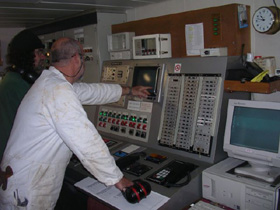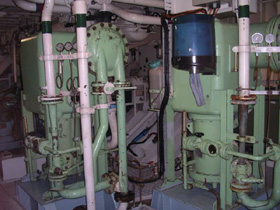Cruise
Log: Sunday, April 11, 2004
|
March
|
|
Sun
|
Mon
|
Tue
|
Wed
|
Thu
|
Fri
|
Sat
|
|
|
1
|
2
|
3
|
4
|
5
|
6
|
|
7
|
8
|
9
|
10
|
11
|
12
|
13
|
|
14
|
15
|
16
|
17
|
18
|
19
|
|
|
|
|
|
|
|
|
|
|
|
|
|
|
|
|
|
|
April
|
|
|
|
|
|
|
|
|
|
|
|
|
|
|
|
|
|
11
|
|
|
|
|
16
|
17
|
|
18
|
19
|
20
|
21
|
22
|
23
|
24
|
|
25
|
26
|
27
|
28
|
29
|
30
|
|
|
| |
 |
| Fred
and Andrew in the engine control room (Photo by Peter Hill/Andrew
Marriner). |
| |
 |
| The
fresh water evaporators which supply our fresh water (Photo by Peter
Hill/Andrew Marriner). |
| |
| |
| |
| |
| |
 |
| Easter
eggs magically appeared on everyone's cabin door (Photo by Peter Hill/Andrew
Marriner). |
Bunny
Hopping on the Southern Seas
Contributors: Peter Hill
and Andrew Marriner
Despite winds gusting
to 50 knots and breaking waves reaching 6m, and under conditions which seasoned
1st mate Alexander Morrice described from the bridge as "fierce to
ferocious, becoming fantastic at times," the Easter bunny still managed
to sneak in under the radar and visit the RV Tangaroa overnight. Little
parcels of chocolate eggs were found taped outside everyone's cabin doors.
Few clues to the identity of the bunny have been found, but Bryan the Teddy
Bear is a strong suspect.
We have arrived at
the Southern Biophysical Mooring site (46° 38'S 178°33'E), but
due to rough seas we're unable to do our planned recovery and redeployment
of the instruments. We'll just have to ride it out today and try tomorrow.
However, many of our underway systems are still quietly measuring physical
and chemical quantities from the world outside our ship. In particular,
John McGregor is operating the wave radar system in some of the roughest
sea conditions observed so far this cruise, and the data should provide
some interesting results. Many biologists are brewing up their bottle
incubations growing plankton, zooplankton and bacteria. Biologists Jill
Peloquin and Karl Safi bravely sample from their tanks at the stern of
the ship high up on the fantail. Today the motion has been so violent
some of their sample bottles have been thrown out of the tanks. And chemist
Lori Ziolkowski from the photochemistry group has her own little high
concentration iron catalyst experiment cooking away, exploring the efficiency
of carbon monoxide production from color dissolved organic matter.
After our long 22-hour steam from our fertilized patch to this mooring
site, our fresh water tanks are nearly full. Because of slow running in
the patch we were only producing 5 to 6 tons per day but the 43 people
on board (plus laboratories) were using 7 tons per day. The four fresh
water tanks of the ship have a storage capacity of 70 tons. On this ship,
fresh water is made in evaporators that use waste heat from the ship's
engine. This engine runs at constant speed, driving the main 1.5 megawatt
power generator and a single variable pitch propeller. The ship's speed,
forward and reverse, is controlled by adjusting the pitch of the propeller
blades. The ship's engineers are Chief Engineer Allan Harvey and 2nd Engineer
Fred de Jager. While explaining the complex workings of the engine room
to us, Fred de Jager showed us some interesting statistics:
Currently sailing
at 2.7 knots
Fuel efficiency: 79.3 litres of diesel per nautical mile
Total distance travelled from Wellington Harbour: 1403 nautical miles
Total fuel consumption: 111,256 litres of diesel
Power consumption: 150 kilowatts
Next Day>>
|